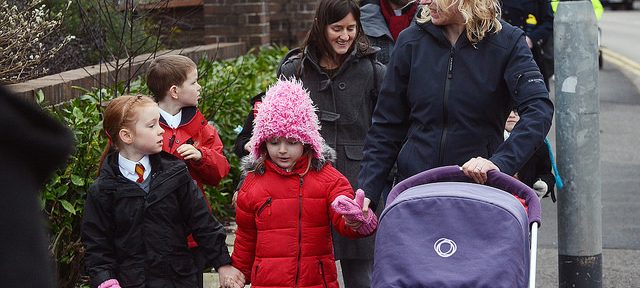Category Archives: Travel

Over 100 London schools ditch the car on World Car Free Day to improve the Capital’s air
“Walking and cycling to school is a great way to get active and tackle London’s toxic air crisis. On this World Car Free Day, and beyond, I would encourage as many Londoners as possible to give up four wheels in favour of going by foot or by bike”
Will Norman
Walking and Cycling Commissioner
Over 100 schools from 18 boroughs will be marking World Car Free Day today by encouraging parents and carers to substitute their car journeys to school with walking or cycling as part of TfL’s sustainable travel to school programme, STARS, to improve air quality in the Capital.
A number of schools across London have set up ‘car-free zones’ near their school gates, while others have ‘park and stride’ spots where parents park a distance from the school gate and walk the rest of the way.
There will also be ‘walking buses’ where children join an organised walk to school, picking up ‘passengers’ on the way as they learn about looking after the environment.
According to the Mayor of London’s research into the health impacts of cars in London, air pollution is a significant health issue with some of the worst pollution hotspots being around schools located on busy and congested roads.
Ambitious
Today’s event follows concerns around the increase in air pollution and congestion on London’s roads. The school run is a major source of traffic and air pollution with school journeys accounting for half the traffic in London between 8:00 and 9:00am during school terms.
The Mayor’s ambitious draft Transport Strategy sets out plans for improving air quality in London by reducing emissions from buses so that all double-deckers operating in the central Ultra Low Emission Zone comply with Euro VI Standard by 2019, ensuring no diesel taxis are granted a first time license in London from 1 January 2018, working to make London’s entire road transport system zero emission by 2050 at the latest and reducing car use on the journey to school.
The Mayor is also launching the toughest emission standard of any city in the world when the T-charge begins on 23rd October. The vast majority of pre-2006 vehicles will need to pay an additional £10 Emissions Surcharge to travel in the central London Congestion Charge zone.
Important first step
This is an important first step to implementing the Ultra Low Emission Zone, which will affect many more vehicles and is expected to reduce NOx emissions by around 50%.
TfL’s STARS programme has been hugely successful in helping primary and secondary school children adopt safe and sustainable ways of travelling, such as cycling, walking and public transport.
Now in its tenth year, the scheme has grown from 180 schools in 2007 to 1,430 in 2017, achieving an average of a 6% decrease in car use.
Just two ten minute walks a day can improve health and wellbeing and reduce the dangers of developing a range of health problems, including Type 2 diabetes, heart disease, some cancers, depression and Alzheimer’s disease.
Great way to get active
Will Norman, Walking and Cycling Commissioner, said: ‘Walking and cycling to school is a great way to get active and tackle London’s toxic air crisis.
‘On this World Car Free Day, and beyond, I would encourage as many Londoners as possible to give up four wheels in favour of going by foot or by bike.’
Leon Daniels, TfL’s Managing Director of Surface Transport, said: ‘Together with the Mayor and working with boroughs we are reducing congestion and improving air quality.
‘It’s great to see our future generations using our STARS programme and World Car Free Day to make the school run green.’
Safer and easier
Tompion Platt, Head of Policy and Communications, Living Streets, said: ‘Making it safer and easier for more families to walk to school is critical to improving air quality around the school gate.
‘Creating safe walking routes, introducing walk to school initiatives and closing school streets to traffic during drop off and pick up times are some of the ways we’re helping schools and parents to ditch the car and choose to walk.’
For further details on the STARS accreditation scheme and the full range of programmes TfL offers to schools and young people, visit tfl.gov.uk/stars or tfl.gov.uk/younglondon.

Transport for London begins search for supplier to build new generation of DLR trains
Customers on the Docklands Light Railway (DLR) are set to benefit from new walk-through air-conditioned trains from 2022.
The new trains, which will increase capacity by over 30%, will be more reliable and provide customers with real time information, air-conditioning and mobile device charging points.
Significant redevelopment is taking place in and around the Docklands area which the DLR serves; in the Royal Docks alone, up to 36,500 jobs and 7,000 homes are being created. To support this growth, TfL will replace two thirds of the existing trains, some of which are 25 years old, and order an additional ten new trains to provide even more capacity.
Danny Price, TfL’s Director of DLR, said: ‘These new trains will enable us to increase capacity on the DLR by 30 %, significantly improving the comfort, reliability and quality of our service for customers. Ordering them now ensures that we get the best value for money in the long term and can support continuing growth in east London. We intend to go out to tender later this year with the new trains entering service from 2022.’
Passenger use is set to continue to grow when the DLR network interchanges with the Elizabeth line from 2018. Services between central London, Shenfield and Abbey Wood will interchange with the DLR at several stations – Canary Wharf, West India Quay, Stratford and Custom House – where new platforms, a new ticket hall and entrance are being constructed.
TfL has published a notice in the Official Journal of the European Union (OJEU) seeking expressions of interest from the train manufacturing industry to build the new trains with improved performance and reliability. A formal Invitation to Tender is expected to be issued in later this year and a contract awarded in Summer 2018.
The DLR celebrated its 30th anniversary earlier this year. It began operating on 31 August 1987, initially running with just 11 trains serving 15 stations. In its first year of operation it carried 6.7m people. Today, the railway – which is entirely step-free – has 45 stations, 38km of track and 56 trains and carries 122 million passengers a year.

Decreased Awareness – Wake-up London!!
In today’s heightened security we are becoming less aware of what’s going on around us, people wearing headphones and walking along looking at their phones. Everyone on the train is completely oblivious of what’s going on around them, people don’t notice when an elderly or pregnant person boards and may need a seat, how are we going to notice a suspicious bag or unattended baggage?
Could Parsons Green have been avoided if someone had noticed the bag and asked the question ‘whose bag is this?’ and got everyone to move away? We’re far too British to dare ask and too engrossed in tech to even notice.

Things need to change, we need to be more aware, look up from your phone and look around the carriage someone might need your seat, someone may be acting suspiciously or a bag that’s been left, there could be a commotion nearby that if you’re aware of could save your life.
Wake-up Londoners your life may depend on it. See a bag alone? Shout out whose bag is this, if no-one answers get well away and encourage others to aswell. See it, say it, sorted.
More reading
5 Ways of increasing your chances of surviving a plane crash
The odds of getting into a plane crash are low. Very low. In fact, your odds are only 1 in 8,357 of dying in an “air and space transport incident,” as the National Safety Council calls it. In fact, you are more likely to die from a lightning strike than to face an aircraft evacuation. But, the reality is, every time you strap yourself to the seat in a metal tube as it hurls itself through the air, you are facing the possibility of an emergency evacuation.
Recent events such as the crash of Emirates flight 521 are a reminder that as safe as air travel is, quick thinking flight attendants and a competent flight crew can mean the difference life and death. Long lines, tight spaces, and elbow rubbing with strangers is now the norm when it comes to air travel. Although packed planes only add to the chaos during an evacuation, with a little foresight and these tips, you will find yourself better prepared in the unlikely event of an emergency.
1. Keep your shoes on during take-off and landing.
Taxi, take-off, and landing are the most critical phases of flight. They are so crucial that flight attendants and pilots are prohibited from communicating with each other unless they are discussing an issue related to the safety of the flight. It is okay to slip your shoes off during flight, but putting your shoes back on prior to landing will prevent you from having to run barefoot across a jet-fuel soaked tarmac.
2. Do not drink or take medication to help you relax.
Sometimes nerves, the desire to start vacation early, or down right fear of flying will cause a passenger to drink alcoholic beverages or take a prescription medication to ease the stress of air travel. And while a cocktail is alright, keep in mind that your blood will be thinner at the high altitude even after cabin pressurization, and this can make the effects of alcohol feel more pronounced. When it comes to prescription medications, make sure you discuss your travel plans and anxieties with your doctor. The chances of surviving a plane crash hinge on two things: the ability of the flight attendants to get the exits open and your ability to get yourself to the exit. Make sure you are sober-minded enough to think clearly and move quickly.
3. Consider the type of aircraft.
Every type of aircraft is different. Even if you fly all the time, you are more than likely flying on different types of airplanes and sitting in different seats each time you take to the sky. Every time you get on a plane, take a minute or two to review the safety information card in the seatback pocket in front of your seat. Look at the diagram of the door and make a mental note as to how it opens. Does the plane you are flying on have slides at all the doors? What about the window exits? If you look closely right before take-off and right before landing, you may be able to catch your flight attendant doing a quick 30-second review once she takes her jumpseat. During this review, flight attendants mentally review what their actions would be in the case of an evacuation. They picture themselves opening the door or over wing exit and mental review evacuation commands. As a passenger, you should be familiar with the evacuation procedures, too. Especially if you are stretching out in the exit row.
4. Know how far you are from the nearest exit.
“Take a moment to locate the exit nearest you keeping in mind that the closest usable exit may be located behind you.” More than likely you have heard these instructions repeated during the safety demonstration before every flight but how many times have you actually taken the time to locate the exit nearest to your seat? Some regional jets don’t have aft door in the back of the plane, so sitting toward the rear of the cabin means going forward to evacuate. Sometimes you may find yourself sitting just a row or two in front of the window exit and didn’t even notice during the hustle and bustle of boarding. Knowing exactly how many rows you are from the exit can make all the difference when trying to find your way through a dark or smoke filled cabin.
5. Do not take anything with you.
This one may be the biggest factor when it comes to quickly and safely evacuating during an emergency. Former flight attendant Bobby Laurie was pretty clear in his most recent Huffington Post article when he said, “Leave. Your. Luggage. Can you hear me? Did you read it right? Leave your luggage. Leave it. Go.” During the recent Emirates evacuation, numerous passengers were seen evacuating with carry-on bags and the cell phone video from inside the cabin is even scarier. Passengers took the time to open overhead bins in an attempt to retrieve carry on luggage. These open bins slowed down the movement of passengers and blocked the flow of egress as people attempted to get out of their seats. Probably the most surprising part watching these passengers attempt to retrieve their bags while hearing the flight attendants in the background yelling “Leave your bags behind! Jump! Jump and slide! Jump and slide!” When a plane is on fire, sinking into the water, or otherwise unsafe to occupy, precious seconds are just that, precious. Do not put your life or the life of another passenger at risk to retrieve you bags. Possessions are replaceable, people are not.
Uber user?
DLR welcomes cyclists aboard following successful trial
Transport for London (TfL) has today announced that, following a successful trial, non-folding bicycles are now permitted on off-peak Docklands Light Railway (DLR) trains on a permanent basis. More than 5,000 cyclists travelled with their bikes on the DLR during a successful trial period that started in July 2013.
The bike trial on the DLR is part of the Mayor’s Vision for Cycling in London, the £913m plan to transform the Capital into a city where cycling is a key part of everyday life. Welcomed by cyclists and cycling campaign groups, allowing bikes on the DLR has opened up many new areas of London to cyclists.
Mayor of London, Boris Johnson, said: “Opening up the Docklands Light Railway to cyclists will be a great boost to the cycling community and make it much more convenient for cyclists to cross the river. This is another important step forward in our mission to make it easier for more people to get cycling in the capital.”
DLR Director Rory O’Neill, said: “All cyclists are now welcome to use DLR services during off-peak hours and at all time on weekends and Bank Holidays. This follows our successful six-month trial during which the London Cycling Campaign provided advice and assistance. I’d like to thank them for their co-operation and input during the trial.”
Serco Docklands Managing Director Kevin Thomas, said: “As DLR’s operator we are delighted to have successfully introduced bicycles onto the railway as another improvement for DLR customers”.
London CC Chief Executive Ashok Sinha said: “We’re delighted to have participated in the trial, and that Transport for London has agreed to allow off-peak cycles on the DLR permanently. This measure will open up new areas of the city to the many Londoners who ride bicycles and provide valuable cross-river links, encouraging more daily cycle journeys.”
Cycling on London’s main roads has risen by 173 per cent since 2001 and this plan will help double the level cycling over the next 10 years. To support this growth, the Mayor and TfL last year announced a range measures to achieve the many aspects of the Vision.
A Central London cycling grid is currently being consulted on; it is a network of 60 miles of quieter routes to encourage less confident cyclists onto their bikes. An additional 80,000 cycle parking spaces will also be installed in residential locations, stations, workplaces and other trip destinations by 2016.
Later this spring, innovative ideas by outer London boroughs will be rewarded when the Mayor announces the winner of his Mini-Holland fund to create cycling havens, delivering dramatic and transformational pro-cycling change.
For more information on the Mayors Cycling Vision, please visit www.tfl.gov.uk/cyclingvision
- Folding bicycles are permitted on the DLR at all times, including during peak hours.
- From 27 January 2014, non-folding bicycles will be allowed on DLR trains from Monday to Friday during off-peak hours (not between 07.30 and 09.30 or 16.00 and 19.00) and all day at weekends and bank holidays.
- We are consulting on plans for a Central London Grid, a mixture of quietways and superhighways in Central London. For more information and to comment on these proposals, please visit http://www.tfl.gov.uk/roadusers/cycling/29172.aspx
- For safety reasons, bicycles are not allowed on trains travelling between Shadwell and Bank stations
Great Short Video on London’s Now Defunct Aldwych Tube Station
Route 11 to start operating with New Bus for London
 Route 11 to start operating with New Bus for London
Route 11 to start operating with New Bus for London
· Routes 9 & 390 will also convert to iconic new buses before end of year
· New buses significantly cut emissions and improve air quality
· Manufacture boosts economy across UK
New Bus for London vehicles will become an increasingly familiar sight for passengers on route 11 from Saturday (21 September), as the route becomes the second in the capital to convert to this iconic, green mode of public transport.
Route 11, which is operated by Go Ahead, runs from Liverpool Street Station to Fulham Broadway, via Bank, Mansion House, St Paul’s, Ludgate Circus, Fleet Street, Aldwych, Trafalgar Square, Westminster, Victoria, Sloane Square and Chelsea. When the route has fully converted, 25 New Bus for London vehicles will be in passenger service during peak periods.
The buses will be introduced on route 11 over several days, from 21 September, and will be responsible for carrying the 23,000 people who travel on the route each day.
It follows the first bus route to be converted to operate entirely with New Bus for London vehicles – the 24 – which runs between Hampstead Heath and Pimlico.
The New Bus for London is the greenest diesel electric hybrid bus in the world. In tests a prototype bus was found to emit a quarter of the NOx (Oxides of Nitrogen) and harmful ‘PM’ particles of a fleet average hybrid bus and 20 per cent less CO2. When all 600 New Bus for London vehicles are in service in 2016 they will reduce CO2 emissions in the capital by around 20,600 tonnes a year.
The buses are manufactured by the family-owned Wrightbus company in Northern Ireland. The order for the 600 New Bus for London vehicles has resulted in the opening of a new chassis plant in Antrim and the safeguarding of 220 jobs, including 18 apprenticeships and the creation of 50 new jobs.
As well as the manufacture of the chassis and superstructure in Northern Ireland, a number of components for the new bus are made by companies from around the UK; including engines from Darlington, seats from Telford, seat moquette from Huddersfield, wheelchair ramps from Hoddesdon (Hertfordshire), destination blinds from Middleton near Manchester and flooring from Liskeard (Cornwall). All of these companies have received a boost as a result of the new bus project.
Accessibility improvements completed at 35 Tube stations
•Boarding ramps now in place at 19 further underground stations
•35 additional stations are now more accessible for wheelchair users from platform to train
•Further accessibility commitments set out by the Mayor are being delivered – with 26 Tube and Overground stations to become step free over next eight years
•Work underway to find additional accessibility solutions at other step-free stations
London Underground (LU) has completed the roll out of boarding ramps, used to bridge the gap between platform and train, at a further 19 Tube stations. This brings the total number of Tube stations where level access from platform to train has been introduced through the use of ramps and permanent raised platform sections to 35 since last year. Two additional London Overground stations, Denmark Hill and Crystal Palace, have also become fully step-free since the Olympic and Paralympic Games.
The portable ramps are put in place by Tube staff to allow wheelchairs users to get on and off trains. They were first introduced at 16 Tube stations during the Games and proved so successful TfL has now rolled them out more widely. The 19 new stations to have boarding ramps are: Caledonian Road, East Ham, Elm Park, Epping, Farringdon, Hainault, Hillingdon, Hounslow East, Kew Gardens, Mile End, Richmond,
Rickmansworth, Roding Valley, South Woodford, Theydon Bois, Upney, Uxbridge, West Finchley and Wood Lane.
A new short film explaining how the ramps work can be found at [youtube http://youtube.com/w/?v=UVJl2IKLa1U] Customers can also sign up for TfL’s accessibility email updates by visiting
tfl.gov.uk/emailupdates
The Mayor of London, Boris Johnson, said, “Boarding ramps proved hugely successful in helping people to get around during the Games and I’m delighted that we are now rolling them out at even more stations across the Tube network. London has one of the most accessible transport systems in the world but there is always more that can be done. This is why we are investing hundreds of millions of pounds to ensure that we take accessibility in the capital to the next level.”
Phil Hufton, London Underground’s Chief Operating Officer said: ““We’ve had really positive feedback about the boarding ramps, as well as other improvements such as permanent raised sections of platforms and wide-aisle gates, which are helping to make getting around easier for many of our customers. We also want to ensure that people are aware of how easy the ramps are to use and a short film on the TfL website shows exactly how they work.”
Ruth Owen OBE, Chief Executive of disabled children’s charity Whizz-Kidz said: “We warmly welcome TfL’s decision to roll out manual boarding ramps at a further 19 stations across the network, which will support disabled people to travel more independently. As part of Whizz-Kidz’s Generation Inspired? campaign into the Paralympic Legacy, we polled our network of young wheelchair-users in the five months following the London 2012 Games and discovered that the majority were hopeful that improvements in transport accessibility would form part of the Paralympic Legacy. We’re delighted that young disabled people’s voices have been heard. Whizz-Kidz and its young Ambassadors back the Mayor’s pledge to make transport in London more accessible and we look forward to continuing to support and advise TfL on further measures to improve accessibility for disabled passengers.’
At some stations factors such as the historic design of the platforms and track – particularly where there is a step down from the platform to the train – mean that the use of boarding ramps has not been possible. Work by LU to find solutions in these cases is now underway.
Many large-scale accessibility improvements are also already underway across the Tube network including at Victoria, Vauxhall, Tottenham Court Road, Bond Street and Greenford Tube stations. A new fleet of trains are running on the Metropolitan line and by the end of 2014 there will be new trains running on the entire Hammersmith & City and Circle lines followed by a further 80 new trains on the District line, which will mean that 40 per cent of the network will be served by air-conditioned trains with high levels of accessibility, wider doors and dedicated areas for wheelchair users.
TfL will also increase the number of permanent raised platform sections to provide level access at a third of stations by 2016 and install tactile paving on all platform edges across the network for the visually impaired.
Currently, 66 stations on the Tube network are step-free, but the gap between the platform and train at some of these stations has meant that wheelchair users can struggle to board.
The new deployment of ramps will mean that, of the platforms that are currently accessible step-free from the street, 76 per cent (149 out of 195) will now be accessible to wheelchair users through the use of the ramps, permanent raised platform sections, low floor trains and other improvements.
Introducing ramps to more of the Tube network was one of the commitments outlined in the mayor and TfL’s ‘Your Accessible Transport Network’ document in December of last year. Progress on a number of improvements outlined in the document have already been made. These include:
Disability organisations Inclusion London and Transport for All have been appointed to improve training given to LU staff in how they assist older and disabled customers;
Centres of excellence, which will act as exemplars for how TfL can best assist disabled customers, are being established at Stratford, King’s Cross St Pancras, London Bridge, Green Park and Westminster stations;
Significant improvements to signage have now been completed at 11 stations with four more to follow this month. This distinctive new accessibility signage, developed in conjunction with disabled people, is positioned at locations and heights that are easily viewable from wheelchairs. It provides better information about how best to navigate stations, including Westminster, Waterloo, Kings Cross and London Bridge;
A further 94 wide aisle gates have been installed at 60 Tube stations, and the number of permanent raised platform sections is being increased to provide level access at a third of stations by 2016;
A fleet of new trains are already running on the Metropolitan lines with more new trains being introduced on the Hammersmith & City, Circle and District lines, and by 2016, 40 per cent of the Tube will be served by new, highly accessible trains;
A world-leading customer information system has now been introduced on the entire Victoria line. For the first time this gives give real-time disruption information to help people with hearing loss who may miss announcements from the driver.
Large-scale accessibility improvements are already underway at Bond Street, Tottenham Court Road, Victoria and other locations
An additional £18m is being invested to make at least 95 per cent of bus stops accessible by the end of 2016, bringing even greater ease to a bus network that is already the most accessible in the country;
TfL is completely redesigning its website with clearer, easier to read content;
A new Twitter feed @TfLAccess has been launched to give advice on getting the most out of the transport network, to update disabled passengers on improvements to their services and to advise customers of any planned changes on the network – such as to lifts, escalators or stations – that may affect their journeys

